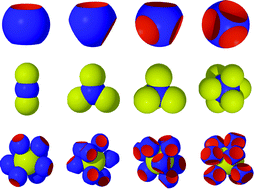Modeling the assembly of oppositely charged multi-indented lock- and key-colloids†
Abstract
The interactions between oppositely charged multi-indented lock- and spherical key-particles are investigated by means of Monte Carlo simulations at low volume fractions. The specificity of the interactions is initially investigated in an excess of either lock- or key-particles, and we find ordered clusters with highly directional bonds. This suggests electrostatics alone to be capable of inducing the assembly of specifically bound clusters. Considering different numbers of indentations and number ratios corresponding to perfect lattices (cubic/hexagonal/diamond), we however only find gel-like structures with no tendency to form dense ordered aggregates or lattices. We conjecture that the high entropic cost that comes with specific binding of several keys to a single lock impedes the spontaneous formation of defined lattices at low volume fractions and “lock” the assembly into disordered gel-like structures.



 Please wait while we load your content...
Please wait while we load your content...